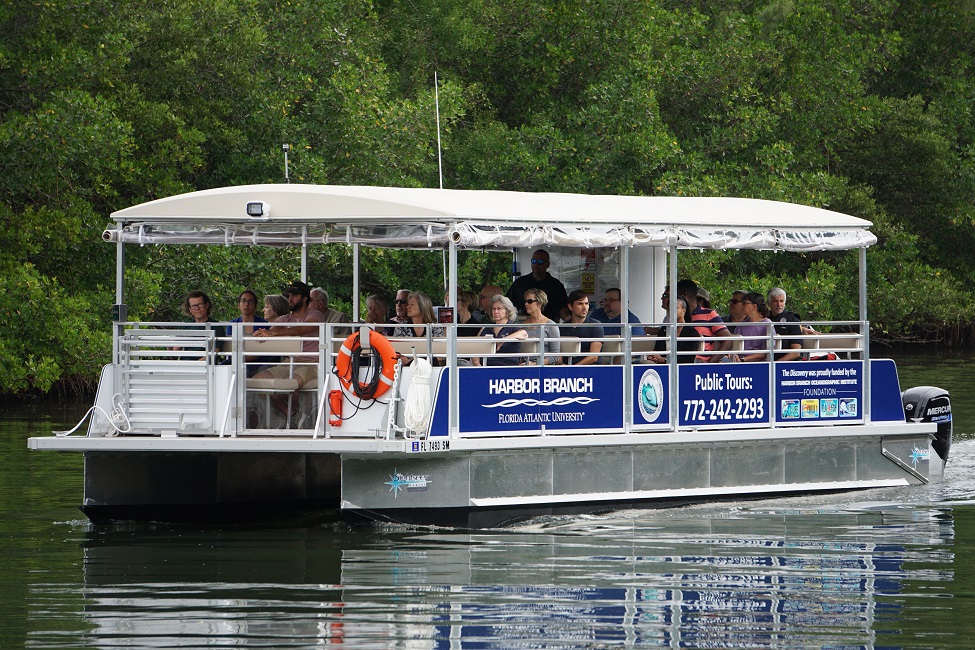FAU Lands U.S. EPA Grant for ‘Hands-on’ Indian River Lagoon Field Trip

The “Discovery,” a state-of-the-art tour boat, will depart directly from the FAU Harbor Branch campus in Fort Pierce, which is located along the Indian River Lagoon.
As the third most populated state in the country, Florida is on the frontline of environmental change. Decades of rapid population growth, the loss of natural areas, and altered water flows have caused widespread ecological shifts. With these increasing concerns, it is critical to inspire the next generation of environmental stewards, scientists and resource managers.
Testing results from 2022 revealed that 52 percent of eighth graders in Florida’s public schools failed to meet national science standards. In addition, science proficiency scores in poorer counties rank below the state average and are significantly lower among students at Title 1 schools. This presents an urgent need to educate children – especially those from disadvantaged communities – about science, Florida’s natural resources and how they can play an active role in a healthy future.
Gabby Barbarite, Ph.D., director of outreach and engagement at Florida Atlantic University’s Harbor Branch Oceanographic Institute, has received a $399,963 grant from the United States Environmental Protection Agency’s (EPA) South Florida Initiative Program to support a new Indian River Lagoon field trip program aboard the “Discovery,” FAU Harbor Branch’s state-of-the-art tour boat.
Over the course of three years, the project will host 125 field trips, which will educate as many as 3,125 socially disadvantaged middle and high school students about Florida’s natural resources and the importance of conserving them. The Discovery will depart directly from the FAU Harbor Branch campus in Fort Pierce, which is located along the Indian River Lagoon.
“With direct access to the Indian River Lagoon, students will have the opportunity to explore an estuary of national significance, while learning about a wide array of habitats and wildlife, anthropogenic threats, stewardship practices and vital research underway,” said Barbarite, principal investigator. “We are very excited about this unique and multi-faceted experience that will include hands-on activities like water quality testing, plankton tows, and benthic surveys. Students will have the chance to get out of the classroom and spend the day in the life of a scientist aboard a floating field lab.”
This project is an expansion of Barbarite’s previous EPA award ($200,000), which educated teens in underserved communities about the impacts of marine debris. As a result, more than 18,000 pieces of trash were removed from local beaches by the 250 junior ambassadors who participated in the program.
For this latest project, Barbarite will work closely with FAU’s College of Education and partner organizations throughout South Florida, including school districts and not-for-profit organizations such as the Boys & Girls Clubs, which serve socially disadvantaged youth from across the state.
“Students in underserved communities are not typically given experiences, opportunities and resources like those we will be offering in our program,” said Barbarite. “This project will directly target and engage socially disadvantaged children, who as residents of southeast Florida are increasingly affected by urbanization, climate change, polluted waterways and emerging contaminants.”
Armed with binoculars and field guides throughout the field trip, students will observe and learn about the plants and animals they encounter. They also will hear about turtle, manatee, dolphin and fisheries research at FAU Harbor Branch, as well as ongoing efforts to understand the impacts of coastal development, climate change and pollution.
As part of the program, students will have the rare opportunity to see below the surface, using FAU Harbor Branch’s Gladius Remotely Operated Vehicle. This underwater drone captures high quality video, which will be streamed live to weatherproof TV screens around the boat. The team will discuss habitats like seagrass beds, oyster/sponge reefs and mangroves, as well as the fish and invertebrates encountered.
Students also will conduct a zooplankton tow, then use portable microscopes to see what they collected and learn why these organisms are important. The research and education projects routinely recover microplastics during plankton tows, so the project team will use this as an opportunity to talk about marine debris and the impacts it has on coastal ecosystems.
Importantly, students will learn about the most vital part of the estuary – its water. During this hands-on activity, they will measure salinity, temperature, pH, turbidity and nutrients, while discussing influences from weather events, nearby landmarks and human activities. They also will have the opportunity to visit one of FAU Harbor Branch’s Indian River Lagoon Observatory Network stations, where weather and water parameters are monitored in real-time and streamed to an open-access website (www.irlon.org).
“Not only will students have the unique opportunity to visit a world-renowned oceanographic institution and an important estuary, they also will learn directly from marine scientists and environmental educators,” said James Sullivan, Ph.D., executive director, FAU Harbor Branch. “After completing this program, students will become more aware of their connection to local watersheds and ecosystems; as well as the negative impacts that pollution can have on their economy, community and species that inhabit the Indian River Lagoon. They will learn from positive role models, work as a team to collect data, and be empowered with actions they can take to be environmental leaders.”-FAU-
Tags: faculty and staff | science | research | harbor branch